
Thank you! Your comment has been submitted successfully. You should be able to view your question/comment here within a few days.
Error submitting comment. Please try again momentarily.
- All Info
- Reviews (287)
- Q & A (0)
- Videos (2)
- Photos
etrailer Trailer Bearings Races Seals Caps - 25580
- Bearings
- Standard Bearings
- 10000 lbs Axle
- 6000 lbs Axle
- 7000 lbs Axle
- 8000 lbs Axle
- 9000 lbs Axle
- 1.750 Inch I.D.
- Bearing 25580
- etrailer
- Race 25520
High-quality, tapered roller bearing is designed for high-speed use. Replacement part uses industry-standard number.
Features:
- Inner diameter: 1.750"
- Matching race (sold separately): 25520
- Application:
- Inner bearing for #42 spindle
- Inner bearing for 8,000-lb and 9,000-lb axles
- Outer bearing for #99 spindle
25580 Replacement Bearing
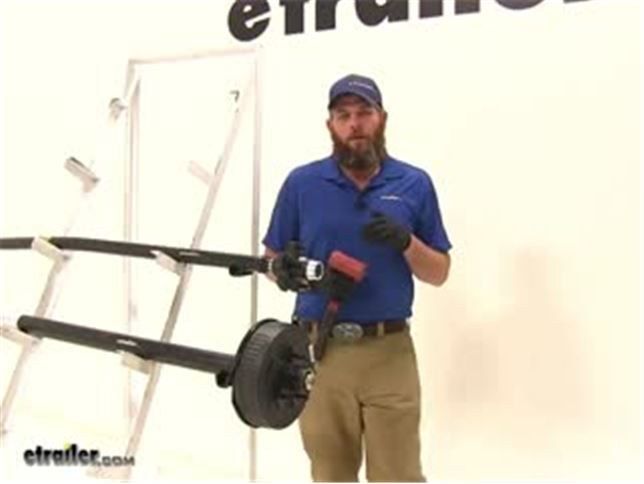

Videos are provided as a guide only. Refer to manufacturer installation instructions and specs for complete information.
Video Transcript for Trailer Bearings Races Seals and Caps Rebuild
Speaker 1: Today we're going to take you through the rebuild process on a couple of hubs. We've got an idler hub, and here we've got a hub and drum assembly. Works with electric rigs, but this can also work for just standard discs, if you've got a disc brake style setup.Basically what we're going to show you is how to get all of the bearings out. How to remove the seal. How to remove the race's if they're damaged, then get them replaced in the proper manner. We'll show you how to use an easy loop hub, which we have here.The first thing we are going to need to do is, get the grease cap off the end.
It can have either a rubber plug in it like this one does, or it can be a solid metal cap.These are pressed fit in there, basically by tapping on them on the back side. To remove them, a deadbolt hammer is typically what we're going to use. We're just going to start tapping as we go around. You'll see a little separation start right here, and slowly it'll work it's way off.Now the next step's going to vary a little bit depending on your axle setup. Do you see this is going to have a keeper that goes around the nut.
And that prevents that from being backed off, or removed. A lot of times you'll have a castle nut, which will have just little tabs that stick off, and there will be a cotter pin that passes through it. Just depending on your application, you need to get the keeper for the nut off. This style we just kind of pry out. A cotter pin you would just remove of course.Once we have that off ...
We'll start to take off the nut here, and the washer that's in behind it. Now yours should look a whole lot more dirty than this. There should be a lot of grease packed in, and through the hub, this one's brand new. We thought it'd be nice to show you the components before the grease was on .. Of our washer that comes off.And then here we're going to have our outer bearing.
Continue to pull that. We're gonig to have our inner bearing here. That sits in the backside of the hub. And we didn't put it in yet, we will show you how to put it in. But a seal would typically be covering the backside here. We'll show you how to use a seal removal tool, or another tool. To get that pried up and out. To get an access to that inner bearing.Now for a drum style like this, that process for disassembly is going to be just the same. One thing to keep in mind if you're using a disc brake setup. You'll have to remove the caliper before the disc is going to come off.Now once we have the spindle exposed, as we said this is going to be really greasy. We want to get all the grease removed, and the first thing we'll do is inspect it. We want to make sure that it looks just like what we have here. Everything's nice and smooth. We don't see any kind of discoloration, or any marring on the metal. Indicating that our bearing's got hot.If you do have any of those symptoms, at this point it's time to replace those bearings. You don't want to repack them. Get new bearings, and put in there. You might have a bearing that's come apart in here. Another surface to ensure is in good condition, is where your seal is going to go. That helps seal all the grease inside of our hub. With a damaged or broken seal, that grease is going to seep out. Either out of the hub, or in this case into our brake assembly.Now if your axle has brakes, we're also going to check the disc. Make sure it doesn't have any issues, or your hub. And this is going to be a hub and drum assembly. The brakes are going to ride on this machine surface. You're going to check that for signs of excessive heat, discoloration, or cracking. And this is our magnet surface. We'll check that surface for the same issues.Now inside the hub regardless if it's a disc brake, it's a drum brake like this. Or just a standard idler style hub. You're going to have an outer race. Would be right here, it's a small tapered piece of metal your bearing sits in, and rotates on. That's basically the outer portion of the bearing.You have the same thing here on the backside. This is called the inner race. Now if those show any signs of wear, overheating, or cracking. Those are also something we'll need to replace, which we'll show you how to do in just a minute.Now, with your brake assembly exposed, if you do have electric brakes like we have here. It's a good idea to check all the components for wear, cracking, maybe missing pieces. Check your pad thickness to make sure those are in good shape. Basically if you have a non working brake assembly and you put everything back together, you're just going to have to take it apart and do it all over again to get back to the brake assembly. This gives you a really good option to be able to change them out.And most applications are going to use a four, or maybe a five bolt flange to hold them in place. And you'll just remove the lock nuts, or sometimes you'll have a hex nut with a lock washer. You want to remove those, and then simply slide your assembly off after you cut the wiring.The friction material itself should also be checked for any kinds of cracking, or overheating. If you have any grease inside the system at all, it's likely it's gotten on those pads. It's a good idea to get those changed. Now as far as the removal of the races go, it's going to be just the same whether we're using an idler style hub like we have here. A drum brake like we have here. You can basically see where the idler is, here in the middle of the hub. It's going to go all the way around there, and we just have this extra material here to provide our braking surface.Now if you're doing a disc brake style job again, it's going to be just the same here with the races living inside of the actual hub portion. You'll just have the discs there for the brakes to make contact. We're going to use this little bit smaller one, it's a little bit easier to manage to show you how to get these out. We've talked about where the races are. The outer here, the inner being closer to the inside, but on the backside of the race there's a little lip. That lip's meant to stick out just a little bit further than the hub, and provide us an area to put our tool on, and help to drive that out.If you look all the way through there on that inner race, you'll see that little lip that sticks out just from the hub slightly, and it gives us enough area to use our tool on. Now generally to remove these you're going to use a punch, similar to this. Some guys will use a screwdriver. Or a piece of pipe. If you have a piece of pipe that's small enough to fit inside of that diameter, you can take that down through and allow it to rest on that lip.Use our punch, and then just need a hammer. And we'll start working that out. We're going to tap all the way around. Kind of equally, and evenly apply the force to get it to come on out of the bottom for us.You can see now as it starts to come out there's going to be a little gap created between the hub and the race. And we can just keep going, bringing it on out. Then you can inspect the inside of the hub surface there. Make sure no damage or anything has occurred, and repeat that same process for the outer race if you plan on removing and replacing that one.Now in the outer flat edge, you can see we're going to have our tapered edge on this side. If we roll our race over to the flat side, typically there's going to be a manufacturers part number on there. That will help you identify which race it is, that you need to go back in your system. If those are rubbed off, worn off, if you can't read them. You can measure the outside, to outside diameter of the race here. It's a good idea to use a micrometer to get it exact.Now here's your basic micrometer. And again, the outside of the race is what we're going to need to measure. You want to go . I set the thickest point there. Looks like this one's going to be about 1.98. That's going to be the measurement you'll want to supply.Now while we've got this out, let's also look at the proper way to measure our bearing. Instead of the outside for the bearing, we need to measure the inside diameter. That's going to be pretty simple. Let's pull that out, find the largest measurement we can. Which here, looks like it's going to be 1.03. With that information, we'll be able to get the correct bearing, and the correct race, so they'll fit together properly and make a full bearing kit for us.Now here's the race, we're going to show you how to get this put back in. Basically just going to press fit inside of our hubs. We need to get it down on there. Kind of like that. And you'll have a couple options. A lot of times you're going to see do it yourself or at homer, just going to use a wooden block. Just place it on there. That's going to get you started, but at that point you'll struggle in getting it to go all the way down into it's seat.Now to take care of that problem, there are several seal drivers that are available. Seal and race drivers that are available out there on the market. It's designed to fit down inside of our race, inside of our hub and get it down there where it needs to go. This is part number ptw83020, has several different sizes, even if you have multiple trailers it's going to do the job.Now the side with the angle on it, is designed to fit down inside of our race. If we use the other side, that's going to be for driving your seal into place. Just want to hold it, and take it on in with your hammer. You'll see, you just want to insure that our race is all the way up against that line on the hub where it's supposed to mate to.Now when it comes time to pack your bearings you're going to have several different ways of doing this. You can just use your hand, is the traditional method. That's going to be the method probably reserved for the very occasional trailer work kind of situation. If you do it once or twice a year, probably get away with it that way.Next you would go to a, kind of a sandwich funnel style almost. If you look inside of there, you can see the bearing. It's located between the two pieces. Just use a grease gun. Start filling that with grease, and that's going to fill our bearing for us. And the third, with this one you're just going to place your bearing down and in. It should be pretty close to center. And then we've got our cone her that's going to go down and secure that.Now I think this style, wastes a little bit more grease than what this style will. This has a dust cap. You can see, you can keep your grease in there, put your dust cap on there and save it for later use. This will be if your going to do it every couple years. And this particular style would be if you're a more regular user.Let's start by showing you how to use a bearing packer. Similar to this. Again, we've just got our grease inaudible 00:11:07 here on the top. And then just slowly start to fill it. Now I like this style quite a bit. I think even regular users might enjoy it, because you can get a really quick visual look at that bearing. You're not going to have to overdo it, or have to much grease.You can kind of see in there now, we're starting to get grease to come out of it. Couple more pumps, we'll be good. You can see we've got grease coming out all the way around. Where all of our bearings are. Got a little bit of excess there. Just take that around the outside of it. And then we should be able to lift it off. And now you can see what we we're talking about. Just a little bit of excess there, that you're just going to wind up wasting.Now we'll take our bearing, we're going to place it right down in our race. And then we'll cap off the back with our seal. Right now our seal's going to fit in just like our race did. It's going to have a little bit of a pressure fit to it. Now very often in this situation, I see people using the four by four method. Kind of here, just placing that on and tapping it. As an option though, if you do have one of these. You can see that's designed to fit right on the top of the seal. And help drive it in.The biggest thing here is, just going to be getting it driven in squarely. You can see, this side's in a little bit further than this side. I'm going to start this side first. Now since we didn't have the opportunity to show you before, we're going to take a look at pulling a seal. Now this is a seal puller, we carry this on our website part number ptw1219. This is meant to hook underneath the seal. And then you kind of pull up on it, and just like our race you'll have to work all the way around that edge. Just bringing it out a little at a time.If you don't have that available. Another option would be a screwdriver. You just kind of get that under the seal, and turn it. And see, that'll allow you to also pop that out. We've taken care of our race. Our inner bearing. Our seal. The last component, before we put our hub back in place is going to be our outer bearing. Now with this bearing, I'll show you the hand packing method.This is definitely . Slightly dirtier method than the bearing packer. When we get grease on our hand we want to look at the larger side of the bearing. This is the smaller side. We have a larger side In between the inside and outside there's a gap. We can see our rollers in there. We want to grab that, and use that gap and shove grease inside of it. Now this is going to take a little bit, you want to work in the same spot until you get the grease pushed all the way through. We can see on the top there we've got a little bit starting to come through.And once we push it in the bottom, and you see it start coming out the of the top in those little drips, it's going to indicate that, that section's fully packed. Just need to work all the way around their outside edge now and do the same thing. Alright, once that's all the way around . The bearing will be ready for use.Now one more thing I like to do. We can see our inner bearing there, and our outer bearing. Well between the two, got a pretty big gap in there. If you'll take a . Pretty good amount of grease. We're just going to go all the way around. See how we can go all the way around the inside and just line that really well. The more grease we have in here, the less chance we have of any moisture getting in there, which can cause corrosion, rust, pitting. Pretty much things we do not like when it comes to bearings, races, and hubs.Put plenty of grease in there. And then this one does have the easy lube spindle, that'll even fill it in more. Now we can get our assembly slid on. I like to keep my thumbs on that outer bearing, just to prevent it from . inaudible 00:15:28 pushed off there. Now we can put on the original hardware that we removed, in taking off our hub the first time. In our case, we had our washer and our nut.Now most commonly you'll see pliers similar to this being used. We basically want to get that tightened down. Once it's fully tightened down you'll feel some resistance in the hub. We back it off just slightly. That'll give us a little bit more freedom of motion there. Something you don't want however . Is any movement in, or out on your hub. You want to be sure that everything is compressed, and you don't have what's called end play. Which would be the play in and out.Once we've got that set, then you'll put on whatever tight keeper yours came with. Get that put back in place. Now with an easy lube style hub, you're going to place your grease gun on the end, and then you can just fill the remainder of that hub up.Now for your typical applications, you're either going to have a solid cap, or a cap that'll have a rubber plug in it. A solid cap's going to be for an axle without the grease inaudible 00:16:51 here on the end. Goes on there. Just knock it on with your rubber mallet. Same with the one with the plug. Just gives you a removable area there, be able to cap that off.We'll show you how to put that on. Now as alternatives as well, a lot of times on boat trailers and marine kind of situations. You'll see a bearing buddy. This is going to apply a little bit of pressure on the grease, you'll fill it up. This kind of comes out just a little bit. That applies constant pressure on the grease to make sure we don't have any air, or anything like that. Then there is also an oil bath hub available. Now this is going to be for use with seals that are going to be designed specifically for oil bath use. You'll have to change that seal.We're using a double lip seal. There are also single lip seals available. Of course a double lip seal is going to give you just a little additional security. Keep that in mind when you order. But let's get this knocked on there now so you can see how that works. We just want to take the cap, we're going to center it. This is going to be very similar to what we did with the seal. And then just gently start tapping it around the outside. And it'll seep down on there for you.It's really going to be the same thing that you'll do with any of the end caps. Now with this side done, it's a good idea to take care of all the other hubs. Get them all on the same maintenance schedule. And as long as you'll periodically check the grease, take your trailer out for a trip occasionally. Just to keep everything lubricated. It should extend the life of these parts, and give us years of good service.
Customer Satisfaction Score:
99% were satisfied with this product
1% of customers were not satisfied
- Wrong item was ordered
- Product did not meet expectations
- etrailer mistake
Customer Reviews
Replacement Trailer Hub Bearing - 25580 - 25580
Average Customer Rating: 4.6 out of 5 stars (287 Customer Reviews)
High-quality, tapered roller bearing is designed for high-speed use. Replacement part uses industry-standard number.Disc brake kit fit perfectly with no issues and was complete. Customer service was outstanding getting everything correct and shipping quickly.
Etrailer is the place to go to. Very knowledgeable with the right part.
All parts arrived, quality OEM replacement parts.
Install went without any problems.
Had to order additional parts I forgot to order the first time. Those parts arrived quickly. I’m a customer for life now !

Everything fit properly and installation went smoothly. All needed parts were included, which was nice. The self-adjust worked well and break-in was quick.
I've only put about 1500 miles on the trailer since install, so I can't speak to longevity.
I'd buy them again though.
Ibbought 4 inner bearings, 4 outer bearings, 4 seals and 4 cotter pins. These were loose in the box with everything else, luckily they didn't damage the loose seals as they rolled around.

Installation was without issue and they are working like a champ!
Worked Great with the the HydraStar Electric Over Hydraulic Actuator for Disc Brakes - 1,600 psi just make sure you find out if you need the HydraStar Electric Over Hydraulic Actuator Adapter Module for Ford and Chevy Brake Controllers - HBA-CAM

bought these bearings and seals approximately a year ago and installed them myself. I watched the instruction video etrailer has a just followed it. Everything went smoothly and we have put approximately 6,000 miles on them since the install. All is good.
Package arrived when promised and product worked as it should

Used this bearing on a car hauler that had mobile home axles on it, fit perfect and good quality.
I bought it due to the fact the original caught fire, and was rendered useless. The people at Etrailer spoke with me on the phone and helped me to find the correct parts needed to get it back on the road.
I would buy again, and will continue to buy parts from etrailer as needed.
The bearing I received was rusted and was not packaged for shipment. It was thrown in a box with some seals and they all rattled around in there. The bearing was not wrapped to be protected from moisture or other damage.
Shipped 8 races and 8 bearings in a box with no packaging materials…. Box was busted and 6 of the 8 bearings had damage to the cages


Jenny N.
11/10/2022
Thank you for reaching out. I will have our customer service team reach out to you.

Bought new axel parts and brakes bigger wheels for my boat trailer. My existing axel was 20 years old and never was adequate for the weight it hauled causing wheel bearings to wear out and the chance of loosing a wheel. This was the most economical way to repair as a new trailer was so expensive. All the parts I needed were available and went together beautifully. Very happy with etrailer, this is not the first time I have ordered from them great option for any parts you need.
Nice bearing

Great quality, great prices. I converted an old gooseneck trailer from the open center mobile home-style hubs to modern 6k hubs on a budget. These fit the replacement hub/brake units that I had. Was able to get all the missing pieces I needed from etrailer.

Great quality, great prices. I converted an old gooseneck trailer from the open center mobile home-style hubs to modern 6k hubs on a budget. These fit the replacement hub/brake units that I had. Was able to get all the missing pieces I needed from etrailer.
Fantastic customer service
Came as planned
All high-quality equipment can’t install until fall due to knee operation

Great product and fast service. I will be back I have other trailers and I have told several or maybe even many people about you. Thank you so much These were mostly bearings and seals for a heavy trailer so I don't have any pictures. Take my word for it though with them

The bearing and race replacements I ordered for my trailer have held up well a year later with 7K + miles on them.
I felt fortunate however that they were not damaged despite how they were shipped from ETrailer. After all these are precision bearings and machined races.
We bought a used 35 ft. 5th wheel this spring and wanted to replace all wheel bearings & seals as well as brakes to start R Ving with good maintenance. The wheel bearings & seals that I ordered from trailer.com arrived very quickly and exactly what I ordered. Preston-Customer Service was awesome and took his time looking up all the correct bearings and seals that I needed.
I would order from etrailer.com again and I will continue to ask for Preston to help me with my orders!
Quick Communication and getting issues resolved quicker than we request
The bearing just arrived as usual with etrailer service was fast and prices fair. I haven't installed these but have purchased this item before. I use them in a large trailer , heavily loaded and often pulled 16 hrs stopping only for fuel. I and my wife switch off.
I service my own wheels and I change bearings if there is any visible change in them. These bearings last several years. I'm satisfied.
Need to ship in better packaging. Boxes came in with holes. Parts were missing.
Replacement parts were sent out but the job is now delayed waiting on the parts.
See what our Experts say about this etrailer Trailer Bearings Races Seals Caps
- Replacement Bearings for 1989 Pace America 20 x 8-Foot Enclosed TrailerReplacement trailer bearings (and races and seals) are most easily identified by using the part numbers stamped or molded into the original parts. The linked photo shows the typical placement and appearance of these part numbers on bearings, races and seals. You can use our search box with these part numbers to find replacements. If you cannot find the part numbers you can instead measure your spindles in the three locations in the photo indicated by the red arrows. These are the points...
view full answer... - How Do You Determine If An Axle Is Rated For 6,000 or 7,000 lb Capacity?It can be very difficult to tell the difference between 6000 and 7000 lb axles because they both typically have a 3 inch diameter. Most of the components for your axle will cover both capacities, so the only way to tell is to look for markings on the axle itself or find a GVWR on your trailer and then divide based on the number of axles.
view full answer... - How to Identify Axle Weighty Capacity Based on Axe Diameter and Bearing Set Used In HubsAn axle's weight rating can often be approximated based on its diameter. Typical trailer axle ratings based on diameter are shown below. 1,000-lb - 2,000-lb Axles: 1-1/2" - 1-3/4" diameter 3,500-lb Axles: 2-3/8" diameter (Can have a 3-1/2" diameter, but rarely) 6,000-lb - 7,200-lb Axles: 3" diameter 8,000-lb Axles: 3-1/2" diameter 9,000-lb Axles: 4" diameter 10,000-lb Or more axles: 5" diameter If you can pull one of the hubs and remove the inner and outer bearings to get their part...
view full answer... - How to Find Replacement Bearings For Griffin Dump TrailerThe best way to match the correct replacement bearings for your hubs is by pulling the hubs off the trailer and removing the bearings; there will be numbers stamped on the back of the bearings in most cases that will provide you with the number bearing that you'll need to use as a replacement. The # 25580 bearing is typically found on a heavier duty trailer with 6000-lbs to 10000-lbs capacity axles. If you've removed the hubs and found that your hubs have bearings with a 1.750" inner...
view full answer... - Can Bushings Be Used to Enable Bearings to Fit in a Mobile Home HubIt is not safe to use any sort of bushing or spacer to allow an incorrect size of bearing to "fit" where it does not fit. The pressure and heat generated within bearings requires extremely precise fit tolerances (and lubrication) and any bearing that was modified to fit in a hub where it does not belong would likely soon be destroyed - which could potentially lead to a very unsafe situation and liability concerns. Also, mobile home axles/hubs/wheels/tires are meant for one-time use only....
view full answer... - How to Determine New Axle for Trailer With Hubs That Cannot be ReplacedThe 1.75 inch inner diameter for bearing is # 25580, which is only used on mostly 7,000 lb to 10,000 lb axles, as opposed to a 3,500 lb camper. Additionally, there isn't a hub with that bearing along with a bearing that has a 1.25 inch diameter, so the best option we can offer is really going to be a new axle. To determine the correct one for your trailer you will need to know the dimensions of your current axle's hub face to hub face and spring center to spring center as in the diagram...
view full answer... - How to Find Bearing and Seal Part Numbers for 1994 Airstream Triple-Axle TrailerWe offer RV hub bearings and grease seals in many sizes; all such parts are shown on the linked page. These are available in single-lip, double-lip and oil bath types. We usually recommend using double-lip seals whenever available since they will do a better job of keeping your hub grease in place without leaks. The best way to find new bearings and seals is to pull one of your hubs to find the original items' part numbers. You can refer to the linked photo to see how these part numbers...
view full answer... - Correct Inner Bearings for Lippert 5K Axles On a 2008 Artic Fox Travel TrailerFor the inner bearing, you're going to need the Replacement Trailer Hub Bearing # 25580, but for the outer bearing you are going to need to remove the hub and check to see what is stamped on the face of the outer bearing as it could be a couple of different options. Once you have this information, feel free to get back to me and I'd be happy to find you the correct outer bearings as well.
view full answer... - Does AL KO 5,200 lb Axle Have a # 42 SpindleYes, an AL KO 5200 lb axle would have a 42 spindle on it. The bearing # 25580 that you referenced is an inner bearing for this spindle/axle.
view full answer... - Axle Rating for Bearing 25580Bearing # 25580 has an inner diameter of 1.75" and is the inner bearing for axles that are between 5,200 lbs and 7,000 lbs. However, it would not be possible to determine capacity on this alone, more information is needed. If you could find the bearing numbers stamped on the bearing themselves it would go a long way towards determining the capacity. I've added a couple links to help articles on bearings which you may find useful.
view full answer... - How to Confirm Which Bearings Are Required by Hub on Lippert AxleThe surest way to know what bearings you need to replace those in an existing hub is to pull one of the hubs and to remove the bearings. Bearings typically have part numbers stamped onto them, as shown in the linked diagram. Once you know the bearing numbers it is easy to search our site. Axles ratings typically go from 2000-lbs up to 2200-lbs and from there to 3500-lbs. We have no 2800-lb axles. All of our AxleTek hubs are shown on the linked page. I also linked a helpful article on replacing...
view full answer... - Replacement Bearing With 1.75 Inch Inner DiameterWe do have a bearing with a 1.75 inch inner diameter, the Replacement Trailer Hub Bearing # 25580. That said, there are numerous bearings with a 1.25 inch inner diameter, and I wouldn't be able to tell you exactly which one you need, so I've linked them below for you. Same for the grease seal I'd need the inner and outer diameters but I've also linked the selection of those for you below. You'll want to measure your spindle where the seal rides to get the inner diameter at least.
view full answer... - How To Find Replacement Hub Components For 2001 TrailerThe best way to find the correct bearings, races, or seals for your trailer is to remove a wheel and hub and get the numbers off of the current components you have. If you are unable to fid the numbers on the bearings or seals or races, you can use a digital caliper to measure the areas on the spindle of your trailer. I have attached a drawing that shows where the numbers can typically be found on the components and where you would need to measure if you are unable to find the numbers....
view full answer... - How to Pick Out Replacement Bearings for Trailer Made in 1990'sWhile we don't have a way to look up what bearings you need I can help you determine the correct bearing numbers. To pick out bearings for a trailer hub you will need to remove one of the hubs so that you can remove the bearings and get the numbers off of them or inner diameters. Or, you can measure the spindle where the bearings ride so that we can pick you out the correct bearings that would fit the spindle. See attached picture. Let me know what you find and I'll see what you'd need....
view full answer... - How to Measure Spindle and Hub to Select Replacment Oil Seal I linked our main page for trailer hub oil seals. You can select a new oil seal by taking precise measurements of both the spindle and hub bore. The spindle measurement will tell you the required inner diameter and the hub bore measurement will tell you the required outer diameter. You'll want to use a precision digital caliper to get your measurements to the nearest thousandth of an inch, like 1.234-inches as an example. Please refer to the linked photo diagram for point B which is where...
view full answer... - Availability of Replacement Trailer Hub Bearing 25580We have the exact bearing part # 25580 that you are looking for. The inner diameter is 1.75 inch like you said you'd need too.
view full answer... - Can 1/4 Inch Brake Line be Used with Electric Over Hydraulic Trailer BrakesWhen installing electric over hydraulic brakes, disc or drum, going to a larger line would be fine but I would keep the size as consistent as possible to avoid any potential issues with a loss or increase in pressure from switching line sizes. If you have to go from one size line to another I would do it as far away from the brakes as you can. At 18 feet, it is not really all that far so 3/16 inch line should be fine. However if you experience slow brake response time then larger lines...
view full answer... - Locating Replacement Hub Bearings for 14 Foot TrailerWe may have the correct replacement bearings/hubs for your trailer, however we do not have any bearings that feature a 5/8 inch inner diameter. What I recommend doing is using a digital caliper to measure the spindle where the bearings sit. Since an exact measurement is need a caliper is the best way to go. I have attached an image to assist. If you don't have a caliper handy you can also try looking for the bearing numbers in your hub assemblies. The numbers should be stamped right...
view full answer... - Picking Out Bearings for 1971 Airstream Land YachtI really wish there was a way to determine what bearings a trailer needed without actually pulling the wheel off and checking, but there isn't. The only two solutions I have for you would be to remove the hubs and get the numbers that are stamped on the bearing or for you to remove the hubs and use a digital or dial caliper to measure where the bearings and seal ride (see pic). With that info I can help you figure out what you need. I attached a link down below that shows all of the bearings...
view full answer... - How to Determine the Right Hub for TrailerWe can tell you how to determine the correct hub for your trailer, but do not have any way of knowing what hub is on it, so you'll have to do some measuring to find out exactly what you need. In order to find the correct replacement hub and drum for your trailer you need to know the weight rating you need, and also what bearings your current hub has. You will need to take apart your current hub assembly and look at the bearings themselves; wipe away the grease and you should be able to...
view full answer... - Does Race Need To Be Replaced If Installing New BearingsYou can use the other components you remove from your hubs. After you have removed the hub components you will want to inspect all of the parts and replace if you find any discoloration or signs of wear or damage such as a nick. On the race you can inspect it and if you see any marks you are not sure about, run your fingernail over the mark and if it catches you should replace the race. The # 25520 is the race you would need for the # 25580 bearing.
view full answer... - How to Tell Torsion Axle CapacityThe only way to tell the capacity of a torsion axle, if you cannot find any markings on the axle itself to identify it, is to remove the hub and check the bearing numbers. You will then be able to reference the hub bearing numbers to the rating of the hub, which will be the same as the axle. For example if you had inner bearing # 25580 and outer bearing # 15123 then it is likely a 6,000 lb axle. Without any identifying markers this would be the only way to know how what your capacity...
view full answer... - Bearing Needed with 1.780" Inner DiameterWe do have the bearing # 603049 which has an ID of 1.781" but it has as OD that is slightly larger than the # 25580 bearing so you wouldn't be able to use the same race. This bearing has an OD of 3.063". We don't currently carry a race for it though as it isn't a very common bearing so that would need to be sourced elsewhere.
view full answer... - Replacement Bearing and Race For Lippert Turning Point Pin BoxWe do have the Bearing # 25580 and Race # 25520 needed for your 16k Lippert Turning Point 5th wheel pin box. Unfortunately, according to Lippert if the inner nylon sleeve is damaged and needs replaced the entire pin box must be changed. And the Turning Point uses an exclusive bolt pattern so that it can only be replaced with another Turning Point.
view full answer...
Do you have a question about this Trailer Bearings Races Seals Cap?
Info for this part was:
















At etrailer.com we provide the best information available about the products we sell. We take the quality of our information seriously so that you can get the right part the first time. Let us know if anything is missing or if you have any questions.





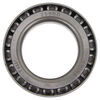











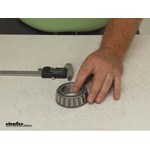




















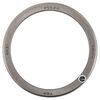
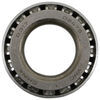



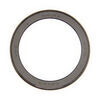


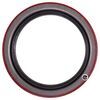
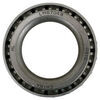









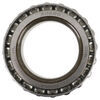






















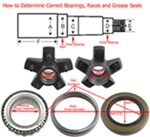


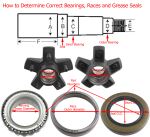
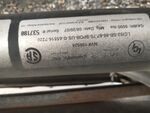

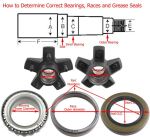
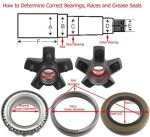
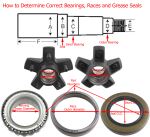
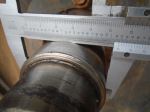


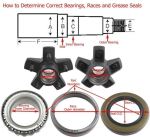
Peter D.
4/10/2019
We sold the trailer 3 months after this review, but everything was working correctly and I have not heard anything from The gentleman who bought it, so have reason to believe it is still working smoothly.